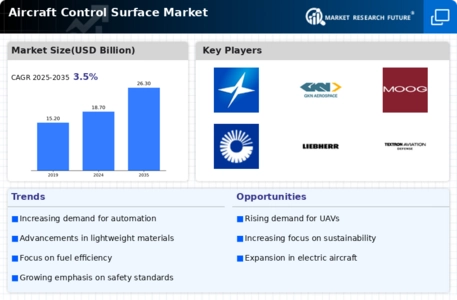Market Trends and Projections
Increasing Military Expenditure
The Global Aircraft Control Surface Market Industry is bolstered by rising military expenditure across various nations. Governments are investing heavily in modernizing their military fleets, which necessitates the incorporation of advanced control surfaces in military aircraft. This trend is particularly evident in countries with growing defense budgets, as they seek to enhance their aerial capabilities. The demand for sophisticated control surfaces in military applications is expected to contribute significantly to market growth, aligning with the overall increase in defense spending observed globally.
Emerging Markets and Regional Growth
Emerging markets are becoming increasingly influential in the Global Aircraft Control Surface Market Industry. Countries in Asia-Pacific and Latin America are witnessing rapid growth in their aviation sectors, driven by rising passenger traffic and economic development. This growth presents opportunities for manufacturers to expand their presence in these regions. As airlines in these markets invest in new aircraft and upgrades, the demand for advanced control surfaces is likely to rise. The expansion of the aviation industry in these regions could further accelerate market growth, creating a dynamic landscape for control surface manufacturers.
Growing Demand for Advanced Aircraft
The Global Aircraft Control Surface Market Industry is experiencing a surge in demand due to the increasing need for advanced aircraft technologies. As airlines and manufacturers focus on enhancing fuel efficiency and performance, the integration of sophisticated control surfaces becomes essential. This trend is reflected in the projected market value, which is expected to reach 18.7 USD Billion in 2024. The push for modernization in both commercial and military aviation sectors drives innovation in control surface design, leading to improved aerodynamic efficiency and reduced operational costs.
Technological Advancements in Materials
Technological advancements in materials significantly influence the Global Aircraft Control Surface Market Industry. The development of lightweight, durable materials such as composites and advanced alloys enhances the performance and longevity of control surfaces. These innovations not only improve fuel efficiency but also reduce maintenance costs, making aircraft operations more economical. As manufacturers adopt these materials, the market is likely to witness a compound annual growth rate (CAGR) of 3.16% from 2025 to 2035. This shift towards advanced materials is indicative of the industry's focus on sustainability and operational efficiency.
Regulatory Compliance and Safety Standards
Regulatory compliance and safety standards play a pivotal role in shaping the Global Aircraft Control Surface Market Industry. Governments worldwide are imposing stringent regulations to ensure the safety and reliability of aircraft. This has led to increased investments in research and development for control surfaces that meet these standards. For instance, the Federal Aviation Administration (FAA) and the European Union Aviation Safety Agency (EASA) continuously update their guidelines, prompting manufacturers to innovate. As a result, the market is expected to grow, with a projected value of 26.3 USD Billion by 2035, reflecting the industry's commitment to safety and compliance.

























